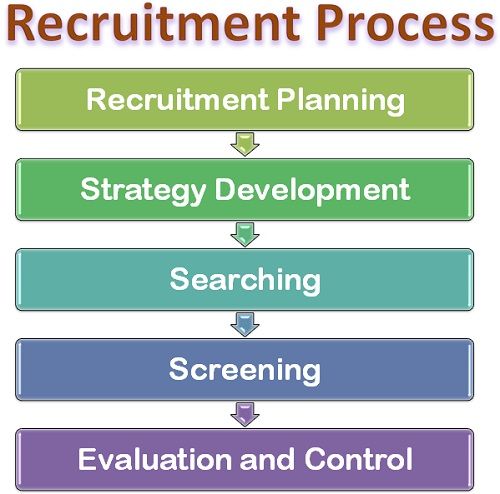Definition: The Recruitment is the process of analyzing the job requirements and then finding the prospective candidates who are then encouraged and stimulated to apply for the job in the organization.
The Recruitment programme is designed to attract more and more applicants such that the pool of candidates applies for the job, and the organization has more options to select the best out of them. The recruitment process consists of five interrelated stages which are as follows:
- Recruitment Planning: The recruitment process begins with the planning where in the vacant job positions are analyzed and then the comprehensive job draft is prepared that includes: job specifications and its nature, skills, qualifications, experience needed for the job, etc.
Here, the recruitment committee decides on the number and the type of applicants to be contacted. The aim of any organization is to attract more candidates as some of them might not be willing to join, or some might not qualify for the job position. So the company has a sufficient number of candidates to choose amongst them. The type of candidates required for the job is well specified in terms of the task and responsibilities involved in a job along with the qualification and experience expected.
- Strategy Development: Once the comprehensive job draft is prepared, and the type and the number of recruits required are decided upon; the next step is to decide a strategy that is adopted while recruiting the prospective candidates in the organization. The following strategic considerations should be kept in mind:
- Make or Buy Employees, which means the firm either decides to select less skilled employees and invest in training and education programmes or hire skilled professionals.
- Methods of Recruitment, the firm decide on the methods used for recruiting the individuals. Such as the internet provides detailed information about the prospective candidates and helps in shortlisting the best-qualified individuals.
- Geographical Area, the next decision is related to the area from where the candidates shall be searched. The firm looks for those areas where the handful amount of qualified employees is concentrated, with a view to curtailing a search cost.
- Sources of Recruitment, there are two sources of recruitment: Internal source (within the organization), external source (outside the organization). The firm must decide the source from where the candidates are hired.
- Searching: Once the strategy is prepared the search for the candidates can be initialized. It includes two steps: source activation and selling. The source activation means, the search for the candidate activates on the employee requisition i.e. until and unless the line manager verifies that the vacancy exists, the search process cannot be initiated.
The next point to be considered is selling, which means the firm must judiciously select that media of communication that successfully conveys the employment information to the prospective candidates.
- Screening: The screening means to shortlist the applications of the candidates for further selection process. Although, the screening is considered as the starting point of selection but is integral to the recruitment process. This is because the selection process begins only after the applications are scrutinized and shortlisted on the basis of job requirements. The purpose of recruitment here is to remove those applications at an early stage which clearly seems to be unqualified for the job.
- Evaluation and Control: Evaluation and control is the last stage in the recruitment process wherein the validity and effectiveness of the process and the methods used therein is assessed. This stage is crucial because the firm has to check the output in terms of the cost incurred.
The recruitment is a costly process as it includes the salaries of recruiters, time spent by the management, cost of advertisement, cost of selection, a price paid for the overtime and outsourcing in case the vacancy remains unfilled. Thus, a firm is required to gather all these relevant information to evaluate the performance of a recruitment process effectively.
Note: In the case of short-term fluctuations in the work volume the firm can resort to other Alternatives to Recruitment.


SWEETY says
THANK FOR GIVING SUCH MEANING
FOR ME IT HELPFUL
KEEP IT UP
paniye gungte says
Thank you business jargon for helping me relating to my academic topic.
Abiodun Darlington says
Am very greaaaaaatful, it really help.
madhu rox says
good job
Madhu says
Good one 🙂
Elangovan MN says
This is really help ! Good one. Thank you !
Rohini says
What an amazingly written article!